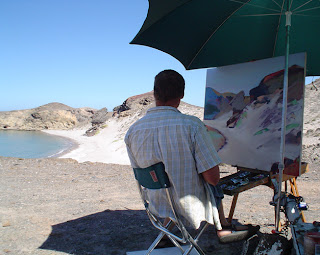 |
| Charles Hawthorne, 11 am |
(Hawthorne was an extremely influential painting instructor at the Cape Cod School of Art from 1900's-1930's, and these quotes are from notes that students took during critiques with him. Just substitute "tone" or "value" for "color" and "drawing" for "painting" and it will all begin to make sense.)
"Pictures are more legible than the printed page, more credible than oratory - there's one thing you can't fool me on - I can read oil painting. I can tell you more what you were thinking about than you yourself knew at the time. Keep your mind clean - what you put on your canvas is an index to your thoughts and I can tell your character by the way you paint. Have an inquiring mind, don't get into a way of doing things. If you do, something stops; you don't grow, you get a fixed habit of mind." (p. 30)
"Be more interested in the workmanlike viewpoint, it is so much more healthy. Be interested in the shadow under a white hat. There are no two white hats alike and each day is different - get into the attitude where you are thrilled by two shadows coming together.
That point of view is so beautiful, so sane that it is worth while in itself. By working with the abstract point of view, that of the workman, one spot against another, we achieve the concrete. This is the only logical way to get at it. Seems simple. It is simple, but one in ten thousand ever achieves it." (p. 35)
"You know too much - an illustrator, aren't you? I thought so. You think you know a great deal about the structure of the face - the bones underneath. Forget all that! Don't try to show me how much you know. Be humble about it. Paint the color tones as they come against each other, and make them sing, vibrate. Don't ask me to look at these self-satisfied, pretty things. That fellow there knows far less about this business than you, yet I'd far rather see his sort of thing, crude though it is. Oh, how refreshing it is to come upon a bit of truth in an exhibition of smug, sophisticated things! That crude sketch would stop you short in any show. It's real, it's flesh in sunlight - there's truth in it." (p. 36)
"That as line composition would probably smash all the canons; everything in it is bad; but how delightful it is in painting! I've often asked people who are in favor of teaching composition, if they can remember a piece of a beautiful painting which is bad composition, and they never can. It comes to this, that if you plotted out a beautiful composition and a master and a dub painted it, the master's would be fine and the dub's very hard to look at. All I can say is, cultivate yourself and your tastes. Grow!" (p. 36)
"Remember that all painting is seeing, not doing. A painter spends his life in despair trying to paint the beauty he sees - in so doing he approaches more beauty. Knowledge will come to you unknowingly. Think of what beauty is revealed to you; try to put that down." (p. 89)
"Don't be the one who knows how to do it, but be the one who recognizes beauty when it comes - then stops. Add to your work that quality of looking accidental. You may not know what you want, but you should know what you don't want. When you get it, be intelligent enough to stop." (p. 91)





























